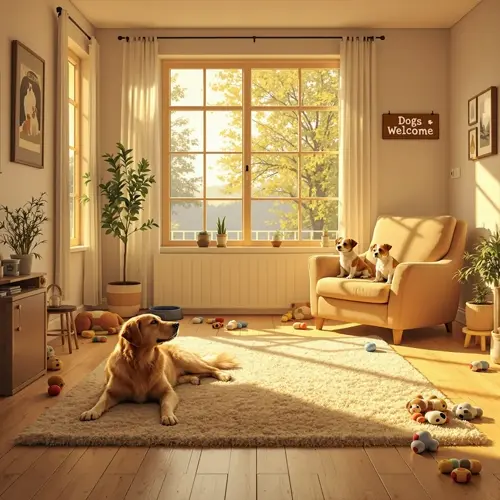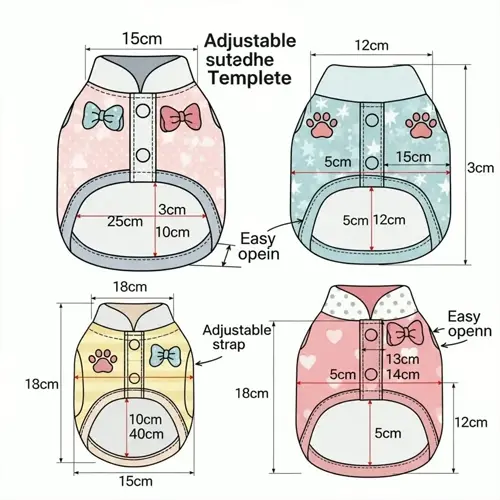10 Essential Dog Crate Training Steps

Written by
David Smith
Reviewed by
Prof. Henry Webster, Ph.D.Training a dog to stay in a crate takes time and you should always use some sort of positive reinforcement method.
Cages should always be sized for your dog to be able to stand at full height and have room to pivot.
Start introducing the crate slowly and at random times while using high value treats (really good treats) to encourage your dog to voluntarily go in.
Never crated a dog that is anxious, if a dog is anxious you have to deal with that before crating it.
Safety in the crate can be achieved by taking off the dog's collar and ensuring there is ventilation.
Lastly, especially if crate training a puppy be conscientious about your dog not not needing breaks for normal activities- puppies need to go out more frequently than adult dogs!
Article Navigation
Through positive reinforcement, dog crate training establishes a safe and secure environment for your furry friend. This method develops the dog's natural den instincts, rather than relying on confinement. It will be helpful when traveling with your dog, house-training, and even for anxiety problems. I have seen dogs actually search out their crates on their own when they are stressed.
Some people think that creating a dog is the same thing as caging the dog, but it is fundamentally different. Dogs seek out enclosed quarters for the security they feel is provided. Proper crate training is not a forced confinement for the dog, but a means of building trust through reward and allowing choice. Most misunderstanding of crating comes from improper techniques.
This resource provides you with useful steps to succeed with dog crate training. You will learn gradual introduction techniques and positive reinforcement strategies that fit your needs. Each dog is different in their learning. I will help you learn techniques that fit your pet's individual personality.
The basis is patience and consistency. If you are rushed, it will be a setback. Small wins matter. For example, if your dog entered the crate on his own, celebrate that. Having a routine consistently helps build your dog's confidence over time. I have trained rescue dogs who have learned to love their crates - you can do this too!
Safety and When to Avoid Crating
Always remove collars before crating. This can save a dog from strangulation if the collar should inadvertently get caught up on a bar in the crate. I once witnessed a close call with a client's Labrador retriever. Non-collared crating is a must for safety's sake. Attaching a harness poses the same danger. Use breakaway collars if necessary.
Controlling the temperature is vital. Direct sun exposure quickly heats crates. Within minutes, temperatures can spike to 20°F (11°C). A parked car with the windows down is still a death trap. Always keep crates in a shaded and climate-controlled space.
Certain health conditions make creating unsafe conditions. Don't crate dogs with arthritis, respiratory problems, or those who have had surgery recently. Brachycephalic breeds, such as Bulldogs, are prone to overheating. Older dogs with mobility issues should not be confined to a crate. If your pet is health threatened, check with your vet before crating.
Crate training increases separation anxiety, and dogs can injure themselves trying to escape the crate. Use baby gates or exercise pens instead of crates. This helps create safe areas without the stress of confinement. I also recommend using pheromone diffusers and calming supplements for anxious dogs. Never crate a distressed animal.
Creating Positive Associations
Food motivation is key when properly training your pets in a dog crate. Use high-value treats such as boiled chicken or cubes of cheese, something the dog cannot resist. These irresistible goodies will encourage their voluntary training. I start each session with special treats that are only available at crate time. This serves to build excitement around the crate area quickly.
Develop a strong box-mealtime connection. Every single meal needs to be served inside the box, with the bowls at the back. To start, close the box door for five seconds. Next, gradually increase the length of time you keep the door shut for over a period of seven days. Then tie it into the routine, so it eventually builds up to the dogs' real excitement barometer.
Begin with simple treats and progress to settling aids. The The first reward is just for entering the crate. Then give frozen Kongs filled with peanut butter. Kongs last longer. Use different types of enrichment toys on a weekly basis to keep your pet engaged and stimulated. This way, they can learn to enjoy calm confinement without constant food rewards.
Never force your dog into the crate. This builds up fear and resentment that lasts forever; let them go in willingly each time. If they hesitate, continue with the earlier steps and reward them. Patience keeps trust. I have watched forced entries undo months of progress in a split second.

High-Value Treat Luring
- Prioritize soft, aromatic treats such as boiled chicken or small cheese cubes cut into 0.5 oz (14g) portions to maximize olfactory appeal and voluntary crate engagement
- Toss treats progressively deeper into the crate space to encourage natural exploration without pressure or forced interactions
- Immediately reward any crate approach with enthusiastic verbal praise using cheerful phrases like 'good crate' to build confidence
- Gradually increase distance between yourself and the crate during sessions to develop independent decision-making skills
- Substitute food rewards with favorite toys once your dog enters the crate confidently without hesitation or reluctance
- After consistent success, phase out visible treats by hiding them inside before your dog approaches the crate area
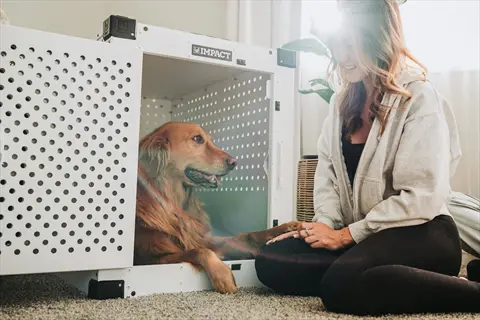
Mealtime Feeding Strategy
- Serve every regular meal inside the crate with food bowls positioned at the very back to require full comfortable entry
- Begin closing the door for just 5 seconds during meals, slowly extending to entire meal duration over seven days
- Utilize puzzle feeders such as Kong Wobbler devices to prolong mealtime and strengthen positive crate associations
- For hesitant dogs, place food bowls just inside the entrance and move one inch further back each day
- With anxious dogs, hand-feed individual kibble pieces inside the crate to establish trust and comfort gradually
- Maintain this consistent routine for at least two weeks after training completion to solidify long-term positive associations

Settling Aids
- Freeze stuffing mixtures like peanut butter combined with kibble inside Kong toys for extended three-hour entertainment sessions
- Select chew-resistant materials: durable rubber options for aggressive chewers, softer plush for gentle-natured dogs
- Introduce new toys in neutral areas first to confirm your dog enjoys them before incorporating into crate sessions
- Rotate three different enrichment toys weekly to maintain novelty and prevent boredom during confinement periods
- Time toy distribution carefully: present them as your dog enters the crate and remove upon exiting to preserve value
- For young puppies, use edible chews like Himalayan yak milk treats in appropriate 6 oz (170g) portions
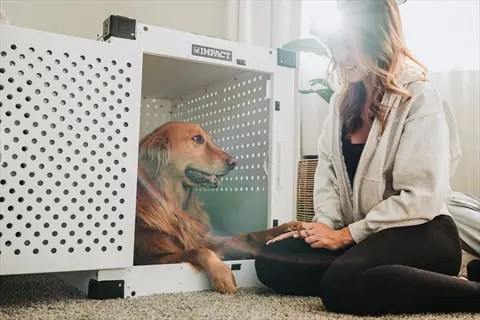
Calm Behavior Rewards
- Reward deeply relaxed postures: lying down with head resting on paws earns higher-value rewards than simple sitting
- Employ 'capturing' methods: silently deliver treats when your dog naturally chooses the crate for voluntary resting
- Begin reinforcing after thirty seconds of quiet behavior, progressively extending to five-minute calm intervals
- Mark desirable conduct with a clicker or specific verbal marker like 'yes' before delivering any food reward
- After consistent success, transition from food rewards to affectionate physical contact like gentle ear scratches
- Document daily progress in a journal, noting durations of calm behavior before reinforcement becomes necessary
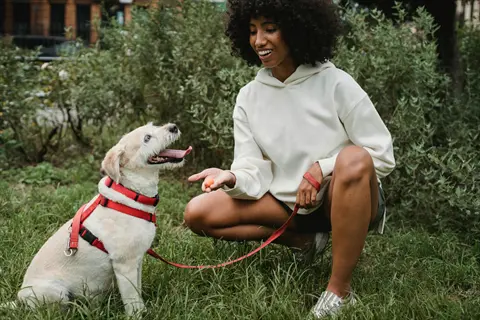
Verbal Cue Training
- Choose one consistent command phrase like 'kennel up' used exclusively for crate entry to prevent confusion
- Verbalize the cue immediately before tossing treats into the crate space to establish strong auditory associations
- Practice five repetitions per session, conducting three sessions daily for optimal learning and retention results
- After establishing the cue, wait several seconds before gesturing to encourage independent behavioral responses
- Incorporate simple hand signals like an open palm toward the crate to create visual command alternatives
- Test understanding after consistent practice by giving commands without treats from 10 ft (3m) distances
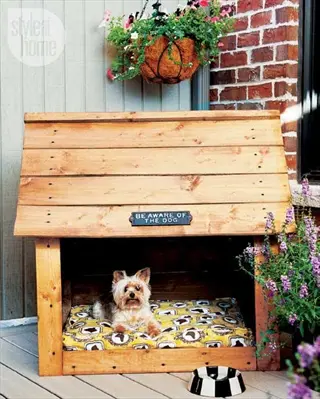
Environmental Enrichment
- Position crates near family activity areas so dogs feel included without being forced into direct interaction
- Apply calming pheromone sprays like Adaptil to crate bedding fifteen minutes before scheduled training sessions
- Add comfort items: unwashed owner t-shirts provide familiar personal scents that security blankets cannot replicate
- For sound-sensitive dogs, play consistent white noise at 50 dB levels to mask triggering sounds like doorbells
- Adjust lighting conditions: cover back and top sections while leaving the front uncovered for visual security
- Maintain comfortable temperatures between 68-72°F (20-22°C) using fans or heating pads as seasonal conditions require
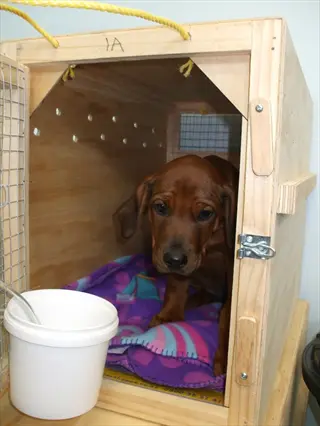
Entry Progression
- Begin with doors fully open, rewarding any paw placement inside before expecting full body entry compliance
- Close doors incrementally: start with five seconds initially, progressing to thirty seconds within three days
- If whining occurs, wait for a three-second quiet pause before opening doors to avoid reinforcing vocal demands
- Develop duration tolerance gradually: one minute calm initially, extending to thirty minutes over two weeks
- Teach 'door manners': practice sit/stay commands before opening crates to prevent rushing out behaviors
- For fearful dogs, introduce confinement gradually using baby gates before transitioning to full crate structures
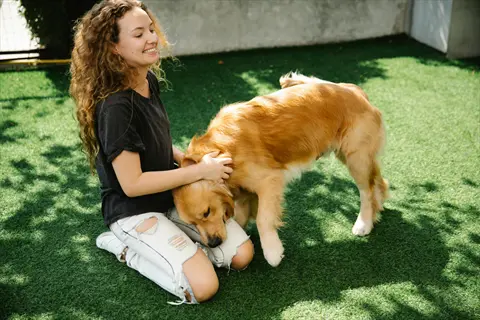
Owner Behavior
- Maintain neutral emotional energy: avoid dramatic greetings or prolonged goodbyes that could transfer anxiety
- Completely ignore attention-seeking behaviors like crate door pawing during the initial two-week training period
- Practice brief departures: leave for just one minute while your dog is settled with engaging chew toys
- Return calmly without acknowledging your dog until thirty seconds after crate exit to normalize departures
- Ensure all household members follow identical procedures to prevent confusing mixed signals during training
- Document reactions thoroughly: note stress indicators like excessive panting to adjust training intensity appropriately

Toy Rotation System
- Maintain seven distinct toy categories: three for chewing, two for licking, two puzzle types rotated daily
- Freeze enrichment items biweekly: soak rope toys in broth and freeze for two hours to maintain novelty appeal
- Measure engagement effectiveness: time how long each toy holds attention to identify optimal enrichment types
- Introduce new toys in neutral areas first to build positive connections before incorporating into crate sessions
- For destructive chewers, select virtually indestructible rubber toys like GoughNuts instead of plush alternatives
- Clean all toys weekly with vinegar solutions to remove saliva buildup and preserve hygienic appeal
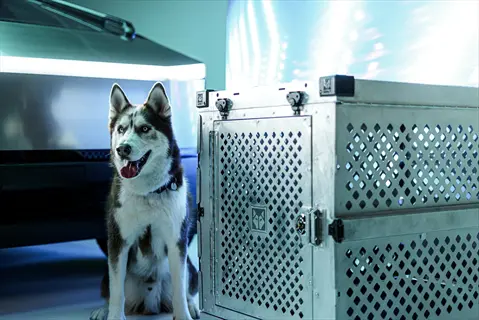
Regression Management
- If whining resumes, immediately return to the last successful training step duration without hesitation
- Identify potential triggers: note environmental changes like new pets or routine disruptions in a journal
- During fear periods, temporarily reduce expectations by fifty percent duration while increasing reward frequency
- Consult your veterinarian if sudden aversion develops to eliminate possible pain-related medical causes
- Use veterinarian-approved calming supplements like L-theanine chews thirty minutes before crating during setbacks
- Maintain detailed progress records noting regression dates and corresponding environmental circumstances
Choosing the Right Crate
The choice of materials for a crate depends on what you already know about your dog's habits and preferences. Wire crates allow the most ventilation, but not as much chew-resistance. Plastic pet carriers are rugged for travel, but they may also hold heat inside. Soft-sided crates can only be used for the quiet dog. Heavy chewers need aluminum crates with tamper-proof locks.
Proper sizing prevents discomfort. Please measure your dog's standing height from the floor to the top of its head. Add to that four inches. Measure the length of your dog from the tip of the nose to the base of the tail. Add to it six inches. The dogs ought to turn comfortably about. Oversized crates often encourage dogs to relieve themselves in the corners.
Brachycephalic breeds such as Bulldogs and Pugs need special care in terms of ventilation. For ventilation, wire crates are the best option. You should avoid using a plastic carrier that does not have modified ventilation holes, as these can be hazardous for any brachycephalic breeds. You should constantly monitor the temperature. These breeds overheat very quickly in confined spaces.
Puppies need dividers. The adjustable walls allow for reduced crate space as your little pup grows. Start with enough crate space for your little one to stand and turn around. Move the divider weekly as the pup grows. This helps keep her from having accidents and allows her to feel secure in her den.
Wire Crates
- Structure: Powder-coated steel bars with removable plastic tray
- Best for: Most home environments and dogs without chewing habits
- Ventilation: 360° airflow ideal for warm climates and anxious dogs
- Portability: Foldable designs with carrying handles for transport
- Safety note: Avoid if dog chews metal; bar spacing should be narrower than muzzle width
Plastic Crates
- Structure: Solid polymer shells with metal door frames
- Best for: Air travel compliance and noise-sensitive environments
- Ventilation: Limited side openings provide den-like security
- Portability: Lightweight but not collapsible; bulkier for storage
- Safety note: Ensure adequate airflow in temperatures above 75°F (24°C)
- Brachycephalic note: Avoid for short-nosed breeds unless modified with additional vents
Soft-Sided Crates
- Structure: Nylon/polyester fabric over flexible frames
- Best for: Temporary containment and car travel for calm dogs
- Ventilation: Mesh panels offer moderate airflow
- Portability: Lightest option; folds flat for storage
- Safety note: Completely unsuitable for chewers or escape artists
Heavy-Duty Crates
- Structure: Reinforced aluminum with tamper-proof latches
- Best for: Powerful chewers and escape-prone breeds like Huskies
- Ventilation: Strategically placed openings maintain security
- Portability: Heaviest option; requires two-person transport
- Safety note: Essential for dogs with crate destruction history
Furniture-Style Crates
- Structure: Wooden end tables with hidden crate compartments
- Best for: Living spaces requiring aesthetic integration
- Ventilation: Limited airflow; requires climate-controlled rooms
- Portability: Not designed for transport; permanent installation only
- Safety note: Monitor for chewing on internal wood surfaces
Troubleshooting Common Problems
Accurately identify whining types. Attention-getting whining stops when disregarded. Distress whining continues or increases. Check immediately for bathroom needs or discomfort. Puppies under four months old require frequent veterinary checks. Wait three seconds of quiet before responding to attention-getting whining.
Address crate avoidance by going back to foundational training. Leave doors open for one week. Place meals just inside the door. Move bowls deeper inside daily. For destructiveness, have heavy-duty chew toys. Make first lessons no longer than twenty minutes to avoid irritation.
Always use non-punitive solutions to fear. Do not scold anxious behaviors. Instead, reduce your expectations by fifty percent in duration. Increase the frequency of rewards for small successes. Any rescue dogs may require different accommodations, such as exercise pens instead of crates.
Take noted breed characteristics into consideration. Huskies will vocalize more naturally than other dog breeds. Distinguish between breed tendencies and true distress. Terriers often need more chew opportunities. Sight hounds prefer more space versus space hogs, environmental enrichment, etc. Build your solutions based on the characteristics and history of your dog.
Persistent Whining
- Identification: Attention-seeking vocalization stops when ignored; distress continues
- Solution: Wait for 3 seconds of quiet before approaching crate
- Duration: Allow 10-15 minutes of ignoring before reassessing
- Special cases: For puppies under 4 months, check bathroom needs every 2 hours
- Breed note: Huskies/Malamutes naturally vocalize more; distinguish breed traits from distress
- Pro tip: Use white noise machines at 50 dB to mask triggering sounds
Crate Avoidance
- Identification: Dog refuses to enter even with high-value treats present
- Solution: Revert to earlier training step with door always open
- Duration: Spend 7 days rebuilding positive associations before retrying
- Special cases: Rescue dogs may need crate alternatives like exercise pens
- Breed note: Sight hounds prefer larger spaces; consider oversized crates
- Pro tip: Feed all meals just inside threshold, moving bowl deeper daily
Destructive Behavior
- Identification: Chewing crate bars or bedding during confinement
- Solution: Provide harder chew toys like antlers or rubber Kongs
- Duration: Limit sessions to 20 minutes initially to prevent frustration
- Special cases: For heavy chewers, use heavy-duty aluminum crates
- Breed note: Terriers need extra chew outlets; rotate toys frequently
- Pro tip: Apply bitter apple spray on crate bars as deterrent
Accidents in Crate
- Identification: Urination/defecation despite proper duration limits
- Solution: Re-evaluate crate size - may be too large allowing bathroom corner
- Duration: Restart house-training with 30-minute confinement periods
- Special cases: Senior dogs may need more frequent bathroom breaks
- Breed note: Small breeds like Chihuahuas have smaller bladders
- Pro tip: Clean accidents with enzymatic cleaners to remove scent markers
Separation Anxiety
- Identification: Panic symptoms like drooling, destructive escape attempts
- Solution: Discontinue crating immediately; consult veterinary behaviorist
- Duration: Requires weeks of desensitization training outside crate
- Special cases: Medication may be needed for severe cases
- Breed note: Velcro breeds like Vizslas need gradual alone-time training
- Pro tip: Practice 1-minute departures without crate daily to build tolerance
Step-by-Step Crate Training Guide
Lead off by introducing the crate with short five-minute sessions, putting very high-value tidbits of food in it. Allow the dog to enter on its own (voluntarily). Repeat this three times a day. Puppies may need four days of this. Adult dogs may take seven days. If it hesitates, move the treats closer to the entrance.
Create feeding schedules inside the crate. At first, close doors for five seconds (during feedings). Increase the time for puppies by seven days. Increase it for adults in ten days if there is a refusal to enter the crates, place feed bowls near the door and slowly move them further in each day.
Practice confinement exercises after exercise. Close the box, but stand nearby. Start with one minute for puppies. Start with 30 seconds for anxious adults. Increase the time to 30 minutes over the next three days and reward calm behavior immediately with a treat.
Conquer exits by briefly stepping out of the room. Start with 30 seconds for puppies. Try 15 seconds for rescue dogs. Return quietly without excitement. Increase to 10 minutes over 5 days. Use pet cameras to help monitor signals of stress.
Crate Introduction
- Setup: Place crate in family area with door secured open
- Puppy approach: Use extra-high-value treats like liver paste
- Adult approach: Progress 50% slower; may need 4 days for comfort
- Technique: Toss high-value treats (boiled chicken) near crate entrance
- Duration: 5-minute sessions, 3 times daily for 2 days (puppies) or 4 days (adults)
- Goal: Dog voluntarily enters crate to retrieve treats
- Troubleshooting: If hesitant, place treats closer to entrance gradually
Mealtime Association
- Setup: Feed all meals inside crate with bowl at back
- Puppy approach: Start door-closing at day 1
- Adult approach: Begin door-closing at day 3
- Technique: Close door during eating starting with 5 seconds
- Duration: Increase to full meal duration over 7 days (puppies) or 10 days (adults)
- Goal: Dog comfortable with closed door during meals
- Troubleshooting: If refuses, place bowl just inside threshold
Short Confinement
- Setup: Dog in crate with chew toy after exercise
- Puppy approach: Start with 1-minute sessions
- Adult approach: Begin with 30-second sessions
- Technique: Close door while staying nearby for 5 minutes
- Duration: Increase to 30 minutes over 3 days (puppies) or 5 days (adults)
- Goal: Dog remains calm with owner in room
- Troubleshooting: Ignore whining; reward quiet behavior
Room Departure
- Setup: Dog settled with frozen Kong in crate
- Puppy approach: Start with 30-second departures
- Adult approach: Begin with 15-second departures
- Technique: Leave room for 1 minute, return calmly
- Duration: Increase absence to 10 minutes over 5 days (puppies) or 7 days (adults)
- Goal: Dog remains relaxed during brief departures
- Troubleshooting: If anxious, reduce departure time
Overnight Routine
- Setup: Crate in bedroom with comfortable bedding
- Puppy approach: Expect 2-3 bathroom breaks nightly
- Adult approach: Usually no breaks unless senior
- Technique: Crate after final bathroom break at night
- Duration: Start with 4 hours, increase to full night over 2 weeks
- Goal: Dog sleeps through night without distress
- Troubleshooting: Respond only to bathroom whines
Alone Time Extension
- Setup: During daytime with interactive toy
- Puppy approach: Max 2 hours for under 6 months
- Adult approach: Can extend to 4-5 hours
- Technique: Leave home for 15 minutes initially
- Duration: Increase to 2 hours over 2 weeks (puppies) or 3 weeks (adults)
- Goal: Dog remains calm during owner absence
- Troubleshooting: Use pet camera to monitor behavior
Command Integration
- Setup: Use consistent verbal cue like 'kennel up'
- Puppy approach: May learn in 3 days
- Adult approach: May require 7 days
- Technique: Pair command with treat before entry
- Duration: 5 repetitions per session for 3 days (puppies) or 5 days (adults)
- Goal: Dog enters on command without lure
- Troubleshooting: Add hand signal if verbal fails
Duration Challenges
- Setup: Dog in crate with long-lasting chew
- Puppy approach: Follow age +1 hour rule
- Adult approach: Max 5 hours daytime
- Technique: Gradually increase confinement to 4 hours
- Duration: Add 30 minutes every 2 days (puppies) or 3 days (adults)
- Goal: Tolerate crate for workday periods
- Troubleshooting: Provide water bowl for sessions >2 hours
Distraction Exposure
- Setup: Introduce mild distractions (doorbell, visitors)
- Puppy approach: Use lower-intensity distractions
- Adult approach: Can handle moderate stimuli
- Technique: Reward calm behavior during disturbances
- Duration: 10-minute sessions with increasing intensity
- Goal: Maintain composure during household activity
- Troubleshooting: Use white noise if overstimulated
Maintenance Phase
- Setup: Occasional crate use post-training
- Puppy approach: Continue weekly sessions until 1 year
- Adult approach: Monthly reinforcement sufficient
- Technique: Random reinforcement with high-value rewards
- Duration: 1-2 sessions weekly indefinitely
- Goal: Preserve positive crate association
- Troubleshooting: Revisit earlier steps if regression occurs
5 Common Myths
Crating is cruel, never anything else. Crates are equivalent to cages which animals naturally find cruel because they go against their nature.
What crates should be is similar to their den environments which they instinctively want for security, when properly introduced. Modern crate training has to do with the voluntary entries and positive reinforcement, and the scientific behavioural pattern shows that dogs choosing crating for themselves in the case of being well-adjusted, obviously look upon crates as good places for them. To confine for a limited time is not cruel, so this method makes crates valuable tools for house-training and behavioural problems rather than means of punishment.
In the same way that adult dogs automatically retain their urine all night, puppies can do likewise.
Young puppies do not have bladder control and their capacity increases about an hour for each month of age. Expecting overnight dryness before the pup is four months old will result in accidents and distress, thus establishing negative associations with the crate. Responsible servitude will include midnight bathroom breaks, gradually increasing the intervals as the bladder muscles get stronger through natural maturity.
More time in a crate will speed the training results and will give a quicker developing better mannered dog.
Too much crating will give excessive stress which, according to veterinary guidelines, will cause anxiety and whimpering and destructive chewing. Puppies need more frequent opportunities to exercise but also to develop. Adults require more mental exercise outside confinement. Gradual training with adequate amounts of freedom will help you establish the bond of trust. A too great emphasis on crating and/or confinement will cause damage to the human-animal bond and the development of the natural expressions of behavior.
Dogs automatically recognize crates as safe dens and thus require no special introduction.
Although natural for canids of the wild, domestic dogs need to be positively conditioned to associate the crate with security. Forced confinement, without gradual introduction, produces fear responses, especially in rescue dogs or those with previous bad experiences. Correct introduction involves weeks of treat-provided encouragement, making the crate an electively chosen retreat rather than an involuntarily imposed limitation.
Crates can offer a permanent solution for behavioral problems like separation anxiety or destructive chewing.
Crates address the symptoms temporarily, but the cause of the anxiety or boredom cannot be cured. Professional behavior modification plans often include desensitization exercises, environmental enrichment, and sometimes medication. Simply crating these dogs will exacerbate the problem(s) and can lead to self-injury because of the intensification of panic responses and absence of addressing coping skills.
Conclusion
Dog crate training provides safety and security when properly administered. It offers the kind of den-like area in which dogs feel comfortable and instinctively seek. When properly done, it prevents accidents while traveling. It reduces anxiety and stress during thunderstorms. I have watched rescue dogs undergo an impressive transformation through this safe place.
Patience and persistence are the bases. Hurrying produces glitches that will take weeks to cure. Follow routines religiously. Celebrate small daily gains. Consistent effort produces lasting results. My most successful clients practiced short workouts, however many times per day, without fail.
Adapt methods and techniques to suit their specific personality type. For instance, a nervous dog must be progressed more slowly. An active dog will require more exercise before being crated. Rescue dogs will need special methods. Constantly observe how your pet reacts to the various techniques used. Adjust methods to suit their comfort levels.
Continue the long-term benefits of positive reinforcement with your dog. Treat them semi-occasionally for going in their crate when not training. Rotate the special crate only once a month. Make all sessions positive for life, keeping the crate a special, safe place for your companion.
External Sources
Frequently Asked Questions
What is the core principle of dog crate training?
The foundation of dog crate training is creating positive associations through gradual, reward-based acclimation. This involves:
- Introducing the crate with high-value treats and praise
- Building duration slowly without forcing confinement
- Ensuring the crate always represents safety and comfort
- Matching training pace to individual dog's temperament
Is crate training beneficial for all dogs?
While beneficial for most dogs when implemented correctly, crate training isn't suitable for every situation. Dogs with severe separation anxiety or trauma history may require alternative solutions. Always prioritize the animal's emotional welfare over confinement goals.
How should owners respond to crate whining?
Address whining by first determining its cause: attention-seeking behavior should be ignored until quiet, while distress signals require immediate attention. Puppies under four months need bathroom breaks. Never punish whining - instead, reinforce quiet behavior with delayed rewards.
What safety precautions are essential for crating?
Critical safety measures include:
- Removing collars to prevent strangulation risks
- Maintaining proper ventilation and temperature control
- Providing chew-proof water bowls for longer sessions
- Ensuring adequate space for standing and turning
- Regularly inspecting for damage or hazards
When should dogs stop using crates?
Dogs can transition from crates when they demonstrate consistent house manners and emotional stability. Some dogs voluntarily use crates as safe spaces throughout life. The transition should be gradual, starting with short unsupervised periods in dog-proofed areas.
Why do some oppose crate training?
Opposition stems from misuse cases where crates become punishment tools or enable excessive confinement. Ethical concerns focus on welfare violations when dogs are crated beyond physiological needs or without proper conditioning. Responsible use requires respecting dogs' physical and psychological limits.
What alternatives exist to crate training?
Effective alternatives include:
- Exercise pens for restricted movement
- Baby-gated puppy-safe rooms
- Tethered supervision near owners
- Behavioral modification programs
- Enrichment-focused confinement areas
Should toys be left in crates overnight?
Only durable, vet-approved chew toys designed for unsupervised use should be left overnight. Avoid plush toys, small items, or anything that could splinter or become a choking hazard. Regularly inspect toys for damage before each use.
How can owners help puppies sleep through the night?
Establish a consistent routine including evening bathroom breaks, calming activities, and appropriate crate placement. Use pheromone sprays on bedding and provide safe chew items. Set realistic expectations based on bladder capacity - young puppies typically need midnight bathroom breaks.
What indicates unsuccessful crate training?
Warning signs include:
- Persistent destructive escape attempts
- Excessive drooling or panting in crate
- Regression in house-training
- Withdrawal or fear responses
- Refusal to enter even with high-value rewards
